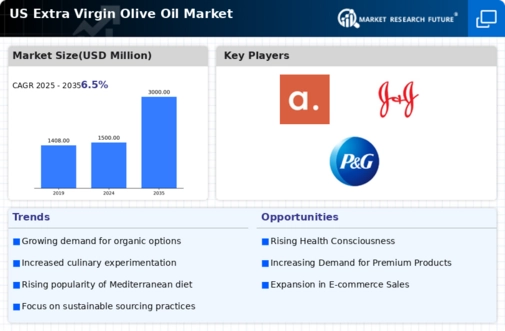The extra virgin-olive-oil market is characterized by a dynamic competitive landscape, driven by increasing consumer demand for high-quality, health-oriented products. Key players such as Bertolli (IT), California Olive Ranch (US), and Pompeian (US) are strategically positioned to leverage this trend. Bertolli (IT) focuses on innovation in product offerings, emphasizing organic and sustainably sourced oils, which aligns with the growing consumer preference for health-conscious options. California Olive Ranch (US) has adopted a regional expansion strategy, enhancing its presence in the U.S. market through partnerships with local farmers, thereby ensuring a consistent supply of high-quality olives. Pompeian (US) has been actively engaging in digital transformation initiatives, utilizing e-commerce platforms to reach a broader audience, which reflects a shift in consumer purchasing behavior towards online shopping. Collectively, these strategies contribute to a competitive environment that prioritizes quality, sustainability, and accessibility.
The business tactics employed by these companies include localizing manufacturing and optimizing supply chains to enhance efficiency and reduce costs. The market structure appears moderately fragmented, with several key players holding substantial market shares while also allowing for niche brands to thrive. This fragmentation fosters competition, as companies strive to differentiate themselves through unique product offerings and marketing strategies.
In October 2025, Bertolli (IT) announced a new line of organic extra virgin olive oils, which is expected to cater to the increasing demand for organic products among health-conscious consumers. This strategic move not only reinforces Bertolli's commitment to sustainability but also positions the brand as a leader in the organic segment of the market. The introduction of this product line may enhance brand loyalty and attract new customers seeking healthier alternatives.
In September 2025, California Olive Ranch (US) launched a partnership with local farmers in California to promote sustainable farming practices. This initiative is significant as it not only secures a reliable supply of high-quality olives but also aligns with the growing consumer interest in sustainability and local sourcing. By fostering these relationships, California Olive Ranch (US) strengthens its brand image and supports the local economy, which could resonate well with environmentally conscious consumers.
In August 2025, Pompeian (US) expanded its e-commerce capabilities by launching a new online platform that offers direct-to-consumer sales. This strategic action is crucial in adapting to the evolving retail landscape, where online shopping continues to gain traction. By enhancing its digital presence, Pompeian (US) is likely to capture a larger market share and improve customer engagement, ultimately driving sales growth.
As of November 2025, current competitive trends in the extra virgin-olive-oil market include a strong emphasis on digitalization, sustainability, and the integration of technology into supply chain management. Strategic alliances among key players are shaping the landscape, enabling companies to pool resources and expertise to enhance product offerings and market reach. Looking ahead, competitive differentiation is expected to evolve, with a shift from price-based competition towards innovation, technology adoption, and supply chain reliability. Companies that can effectively leverage these trends are likely to secure a competitive advantage in the increasingly crowded market.














Leave a Comment